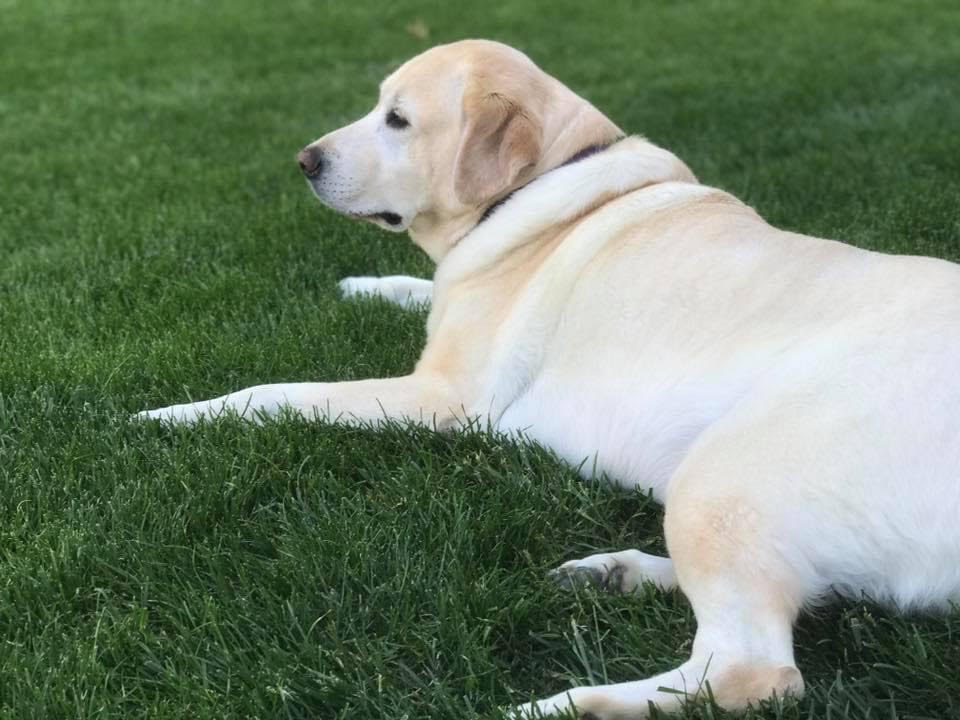|

The Cranial Cruciate Ligament (and Important Points Regarding Its Injury)
The CrCL, sometimes called the anterior cruciate ligament (ACL), is the most important joint stabilizer in the knee. It connects the femur (thigh bone) to the tibia (shin bone) and prevents the tibia from sliding forward during normal leg use. CrCL rupture is the most common source of knee problems in all sizes and breeds of dogs with all levels of activity. The ligament may be either fully or partially torn, but once damaged, has virtually no capacity to heal. Instability results, producing knee pain that manifests as lameness. Only surgery can restore proper limb stability and function.
Canine cranial cruciate ligament rupture (CrCLR) has long been recognized as a surgical disease. Of large breed dogs with CrCLR, 81% to 100% remain lame unless surgical correction is performed. In small dogs (< 10 kg) and cats, exercise restriction, weight loss, and physical therapy have been recommended for treatment of CrCLR, with reported lameness resolution ranging from 73% to 90%.
Currently, the 3 most widely accepted surgical procedures are:
- Tibial plateau leveling osteotomy (TPLO)
- Tibial tuberosity advancement (TTA)
- Various extracapsular stabilization procedures, including the TightRope (arthrexvetsystems.com).
Extracapsular Lateral Suture Stabilization (ELSS) Surgery for Dogs
Extracapsular Lateral Suture Stabilization (ELSS) is a surgical procedure that provides stability to the unstable canine knee. The instability is the result of a torn cranial cruciate ligament (CrCL). Knee stability is necessary for proper leg function and comfort.
Frequently asked Questions About Extracapsular Lateral Suture Stabilization (ELSS)
How does extracapsular lateral suture stabilization work?
The ELSS works by counteracting tibial thrust with a specifically placed suture. Tibial thrust is caused by the transmission of weight up the tibia (shin bone) and across the knee, which causes the tibia to “thrust” forward relative to the femur. It is because the top of the tibia is sloped, not flat, that forward tibia movement (thrust) occurs. The CrCL normally opposes this force, but when torn, is incapable of preventing tibial thrust. The ELSS counteracts tibia motion by “anchoring” the tibia to the femur with a specially placed suture. To accomplish this, a monofilament suture material is passed around the fabella (a pea-sized bone attached to the femur). The suture is then passed through a bone tunnel created at the front of the tibia and looped back and attached to itself.
Can extracapsular lateral suture stabilization be performed in any size dog?
In school we were taught that any dog over 45 pounds, any overweight dog, any dog with issues in other leg, and overactive dogs had to have a TPLO which is another surgery done to repair CCL injuries. We have done ELSS on dogs as big as Great Danes and Newfoundlands, dogs with injuries in other leg, and rambunctious dogs because the cost of the TPLO makes it out of reach of many owners. We have had excellent results in these dogs.
What is the success rate of these surgeries?
Extracapsular stabilizations result in improvement in 85% to 94% of dogs.
Lameness may reoccur in some dogs with advancing arthritis or those in which the periarticular fibrosis is not sufficiently strong to limit abnormal thrust when the artificial ligament fails. Based on experience, Dr. Hoyt instructs clients to expect that 10% to 20% of dogs with extracapsular stabilization will require treatment or reoperation for lameness during their lifetimes, sometimes years after the original surgery.
We define success with ELSS as dramatic improvement in limb function, resolution of pain, and a return to normal or near normal activity. Based on these measures, dogs we have performed ELSS on have a success rate of better than 90%. Even though our results have been very consistent with this procedure, because of the nature of a CrCL injury, it is not realistic to expect every patient to have the exact same recovery or results. Some dogs may have some limitations with more intense activities or have intermittent knee stiffness following injury and an ELSS procedure. Our goal is that 6 months post-surgery, it is difficult to tell which leg was repaired.
What are the potential complications with this surgery?
Dr. Kelly Hoyt has tremendous experience with this procedure, and the complication rate for ELSS as performed by our surgery team is very low. Low-grade infections uncommonly develop, and when they do, resolve completely with proper treatment. Anesthesia itself carries a small risk of complications. At Wellsville Animal Hospital, we take many precautions to ensure that anesthesia is as safe as possible. Patients are monitored throughout their anesthesia by vital sign monitors and dedicated staff.
How long will my dog stay in the hospital?
ELSS patients stay overnight after the surgery is performed and are released the next day.
Should I stop giving my dog’s medications before surgery?
Medications for conditions such as diabetes or low thyroid function should not be stopped. Medications for knee pain may be continued up to the day of surgery. Oral steroids (even for skin conditions) should ideally be stopped one week prior to surgery.
What is the surgery aftercare?
The most important thing following surgery is restricting your dog’s activity, especially for the first six weeks. No off-leash walks are allowed during this period, and leash walks should start light and gradually increase in length. Stairs and slippery floors must be avoided for the first six weeks following surgery, and no jumping, playing or running is allowed. When your dog is not under your direct control, he/she should be kept confined to a small room, cage or crate. All of these restrictions will be discussed with you and written down at the time of your dog’s discharge. We sometimes dispense medication to help keep your dog quieter during recovery.
Do I have to bring my dog back to for a check-up?
We ask that dogs return for staple removal 10-14 days after surgery and then 30 days post-op for evaluation.
Will arthritis develop over time?
Many patients already have at least mild arthritis at the time of surgery. Arthritis can be a cause of and/or a result of a torn CrCL. Once the ELSS is performed and the instability is resolved, improved knee function and comfort is expected, even in the presence of severe arthritis. As your pet ages its possible medication to treat arthritis may be needed.
Can my dog re-injure the same knee after ELSS?
We have not observed significant lameness due to re-injury. Occasionally dogs will develop short-term lameness after a fall or other injury. Rest and anti-inflammatory medication normally result in the return of comfortable limb function in these dogs.
What is the chance that my dog will rupture his/her CrCL in the other knee?
Approximately 40% of dogs will rupture the opposite CrCL at some point in their lifetime.
Is there anything I can do to prevent CrCL injury in my dog?
It is well established that overweight dogs have a greater risk of CrCL injury. Weight management is recommended and will benefit both the operated and unoperated leg.
What happens if I don’t have surgery for my dog?
Permanent lameness and progressive severe arthritis are expected in patients that do not have surgery to treat a torn CrCL. Markedly decreased activity level, chronic knee pain, and diminished quality of life are expected.
Is an ELSS the only treatment available for my dog?
No. Other surgical options do exist for CrCL injuries. Many combined factors are considered in technique selection. If you have questions about other options for your pet, please ask.
Clinical Comparisons
In one study comparing TPLO and lateral suture stabilization outcomes, there was no difference in objective kinetic parameters at 2 years, although a more recent study showed TPLO outcomes were always better than lateral suture outcomes over any time period up to 1 year.
A randomized, blinded clinical trial that compared lateral fabellar suture stabilization with TPLO in 80 dogs with naturally occurring cruciate disease concluded that TPLO resulted in higher peak vertical force and higher owner satisfaction 1-year post surgery.
Finally, extracapsular stabilization may result in increased progression of radiographic osteoarthritis (OA) compared with TPLO.
SUPPLEMENTAL MEDICAL MANAGEMENT
Weight Reduction
Surgery should not be delayed in obese patients at time of CrCLR diagnosis; however, weight reduction is recommended for these dogs postoperatively. Optimally, all dogs with OA due to CrCLR should be fed commercial diets high in omega-3 fatty acids for long-term treatment of stifle inflammation and OA.
Physical Rehabilitation
Physical rehabilitation may be useful to improve or speed functional recovery in postoperative patients, particularly dogs that remain persistently lame.
After TPLO, loss of motion greater than 10 degrees occurs in 21.8% of dogs, and dogs with decreased range of motion are more likely to exhibit lameness. In 1 study of dogs after extracapsular stabilization, 6 months postoperatively, dogs that had a prescribed postoperative rehabilitation program bore more weight on the affected limb than dogs in an exercise-restricted group. Physical rehabilitation in the treated group consisted of walking (10 min) and swimming (10 min) twice daily during weeks 3, 5, and 7 after surgery.
Regardless of the technique chosen, extracapsular stabilization techniques or tibial osteotomies should result in 85% to 95% improvement after surgery. No current technique will result in return to normal weight bearing in all dogs, but each technique has been proven to improve lameness and patient comfort for long periods of follow-up in most dogs, and to result in high client satisfaction. No current technique completely halts OA progression.
| 
